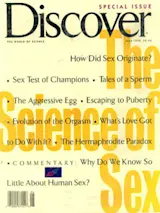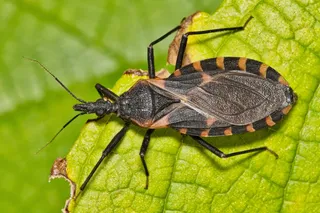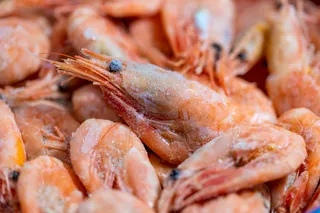Navanax inermis--a rat-size, yellow-dotted brown-and-blue sea slug--is a bit odd even by the laid-back standards of its native California. It crawls around mud flats on a single foot, from which extends a round flap of sensitive skin. Much of the time the slug wraps this cloak of flesh around its tubular body, making it look like an undulating, psychedelic enchilada.
Its weak eyes supplemented by a phenomenal sense of smell, Navanax creeps about the shallows of salty inlets, grasping and gulping down other creatures with the suction it creates when it rapidly stretches its innards. When two Navanax meet, one usually tries this on the other. Only if the other is too big to snack on, or if one approaches the other from behind, do they turn to the next best thing, which is having sex.
It’s sort of a legend up and down the West Coast, says zoologist Janet Leonard of Oregon State University’s Marine Science Center. Navanax, the ‘if you can’t eat it, mate with it’ animal. Befitting stereotypes about life in southern California, she says, Navanax doesn’t seem to have much else on what could loosely be termed its mind.
In fact, Navanax and its fellow sea slugs have become a favorite of neurobiological researchers precisely because a slug’s brain and behavior are a lot easier to map than, say, a cat’s or a mouse’s. Yet when one Navanax creeps up behind another and initiates sex, both slugs soon face a decision that’s almost never addressed by grander, fancier brains: when to be male and when to be female.
Navanax, you see, is a hermaphrodite: like many other species in 9 out of the 16 animal phyla, it has the anatomy and the ability to be either male or female. And Navanax gets to choose between the genders over and over again--it never has to settle for one or the other.
But it does have a preference. That in itself isn’t surprising: according to conventional theory, Navanax should prefer to be male. The name of the mating game, after all, is to pass along the most DNA, and sperm cells, which are small, require far less energy to make than do the much larger eggs. Eggs are expensive, but the world is awash in sperm-- literally, if you count pollen, says evolutionary biologist Eric Fischer of the National Audubon Society. Accordingly, females make many fewer eggs than males make sperm. And while males try to spread their inexpensive, abundant sperm far and wide, females try to invest their precious and limited store of eggs carefully.
According to this energy model, then, a hermaphrodite should want to spend more of its time as a male, the sex in which it can beget the most offspring while expending the least energy. The trouble is, Leonard says, Navanax doesn’t fit this supposedly universal scheme. Navanax prefers being a girl. And, Leonard adds, the slug’s preference is based not on energy efficiency or lack thereof, but on a greater ability to control its destiny.
Leonard didn’t set out to strike a blow for sea slug feminism. She was initially interested in watching her slugs play sex games. Indeed, Leonard has been peeping in on and videotaping Navanax sex (usually in marathon all-night sessions) for more than a decade now. And, she reports, it’s a curious affair. Every Navanax comes equipped with a penis on the right side of its head; a few inches behind is a genital slit that leads to an ovary. Mating begins when one slug follows the trail of another and comes up from behind. The first slug pokes its head under the other’s tortilla of skin, twisting around to position its penis near the other’s genital opening. The second slug responds to this courting by raising its tail and unwrapping the sheath of skin around its body. After the sperm has passed from the first animal to the other, the female swings around and begins nudging its penis toward the genital slit of the male. If all goes well, they exchange jobs. And that’s when the games begin.
The animals keep trading roles, four, five, or more times--The record number I’ve seen is seven, says Leonard--as the hours pass. Fittingly, it’s a sluggish affair. One round of copulation, Leonard sighs, can take five hours. One of the first things you learn working with these animals is patience.
All this trading comes about in an attempt to keep things fair, to let each slug have the same chance at passing on its genes. But why do they keep cooperating? Why does one slug care if the other gets a fair shake? The answers lie, surprisingly, in the theory of games first published in the mid-1940s by mathematician and computer theorist John von Neumann and economist Oskar Morgenstern. Game theory is more often applied to the puzzles of arms control and economic planning, but its tenets can also explain the behavior of an animal like Navanax.
Consider the options faced by a typical Navanax just after it has successfully mated--at the moment, that is, when it is expected to change roles and begin another round. At that moment it enters into perhaps the best-known situation in game theory: the Prisoner’s Dilemma. The situation is commonly illustrated like this: You and a friend commit a crime and are arrested. The police don’t have enough evidence to convict you on the most serious charge, so they try to strike a deal. Each of you, while in solitary confinement, is told that if you’ll testify against the other, you’ll receive no jail sentence but your partner will get the maximum. The catch is that if both of you agree to snitch, you’ll get only a slightly reduced jail term. On the other hand, you know that if neither of you snitches, the police will be able to convict you of only a lesser crime, and you’ll serve just a short sentence.
At first glance, it would seem to make the most sense for the two of you to cooperate with each other, say nothing, and thus be assured of a minimum jail sentence. But the option of getting off scot-free is awfully tempting; besides, there’s always the chance that if you refuse to snitch, and your friend gives in (defects, in game-theory terms), you’ll be in for the maximum. Thus, the worst possible outcome for you--the sucker payoff--is not the result of your acting uncooperatively with your partner but of cooperating and not being paid back. To avoid the sucker payoff, then, your best bet seems to be to defect--to snitch, knowing that at worst you’ll get a reduced sentence, and at best you’ll get off completely.
A hermaphrodite like Navanax faces similar options, says Leonard. After one pairing between two hermaphroditic creatures, when it’s time to exchange sex roles, each faces a choice: duly take on the other role, or defect by refusing to take its turn.
Obviously, an animal should defect only if that furthers its chances of getting the best possible reward--passing on the most genes, in other words. According to the energy model, remember, the best way to do that is for the animal to use its cheap, abundant sperm. So for the slug, it would seem, the best scenario would be the one in which it plays the male role, then defects. The worst scenario would be for it to play the female role and then not get to switch. Why, then, do the slugs cooperate and risk the sucker payoff? Or, to put the same question more broadly, why don’t permanent cheaters--mutant single-sex slugs--arise and wipe hermaphroditism out?
The answer, simply, is that in Navanax’s world, unlike the prisoner’s, this is no one-shot decision. And when you have to play the game over and over again, your strategy has to change.
Theoretical confirmation of this was found a decade ago when political scientist Robert Axelrod challenged game theorists, psychologists, sociologists, economists, and other social scientists to find the best way to play round after round of Prisoner’s Dilemma. The most successful of the 76 computer simulations eventually submitted was devised by game theorist Anatol Rapoport. Rapoport’s method was also the simplest. It was called Tit for Tat, and it lived by only two rules: Always cooperate with the other player on the first go-around. Then, at every later encounter, do whatever the other did at the last one.
Tit for Tat is a friendly and reliable strategy; though it is swift to punish betrayal (because a player does whatever was just done to him), it is forgiving at the first sign of cooperation (for the same reason), and a player adhering to it will never be the first one to defect. More selfish beasts might get the better of Tit for Tat in a single encounter, but as the rounds go by, Tit for Tat strategists make more steady progress.
Thus, in theory, creatures who switch sex roles should have a strong predilection for a Tit for Tat mating strategy. But is this in fact how such animals behave?
Some real-life support for the theory comes from studies of hermaphroditic fish conducted by Eric Fischer when he was a graduate student doing research in Panama. One of the species Fischer studied was the black hamlet, a hermaphroditic sea bass. For the black hamlet, mating-- and cooperation--begins when one fish takes the female role and releases just a few of its energy-expensive eggs; the male-acting fish then ejects its cheap and plentiful sperm into the water to fertilize those eggs. The fish then switch roles, with the former male releasing a few eggs of its own, and the former female getting its chance to play the male.
By parceling out its eggs this way, says Fischer, each fish leaves itself the option of defecting if the other fish cheats by not releasing eggs in turn. If the first fish was to release all its eggs at once--to spend all of that energy in one shot--the other fish could cheat with impunity by fertilizing all the eggs and then refusing to take its turn as a female. So egg trading, Fischer says, fits the game theory nicely. I started out thinking that Tit for Tat did not apply, but then I worked it out and it fit to a T, he says.
Like Fischer, Leonard has been studying a species’ penchant for role-playing and how that behavior can be explained by the Prisoner’s Dilemma model. Yet, though her studies and Fischer’s are mutually supportive in many ways, the two researchers are at loggerheads over one important detail: for Navanax, Leonard has found, the more desirable role is the female one.
It was while watching the slugs play out the Prisoner’s Dilemma that Leonard made her startling discovery. She noticed, after keeping an eye on them for, oh, 12 or 15 hours, that they seemed never to pass up a chance to play the female, but they did from time to time pass on the chance to play the male. In fact, Leonard thinks, females sometimes try to end copulation early so that the partner will come back as a male and they’ll get to play female twice in a row.
The assumption in the energy model of mating is that playing the female role, while useful, is really just a means to the more desirable, less expensive job--playing the male. This, after all, is the point of egg trading: I’ll let you act as the male to my eggs if you’ll let me be the male to your eggs. All cheating observed in the black hamlet involved staying in the male role, refusing to take a turn as female--behavior strongly suggesting a preference for being male. Moreover, it’s the fish that does the most vigorous courting that first takes the riskier female role. That fits game theory logic: the animal that starts mating signals its willingness to cooperate by taking the less desirable role.
But Leonard had already noted that Navanax cheats to stay female, not to stay male, to get sperm rather than to give it. And she also knew that Navanax courtship is initiated by an animal in the male role, when, according to the rules of the game, it should be the animal in the less- desirable female role that makes the sacrifice to start the ball rolling.
The most likely answer, Leonard realized, was that Navanax are the mirror image of the black hamlet. They are trading sperm, she says, rather than trading eggs. Instead of I’ll play female for a chance to be male, it’s I’ll play male for a chance to be female. In Navanax, apparently, it’s not the relative cost of sperm or eggs that determines the more desirable role. Navanax’s eggs are still more expensive to produce than its sperm, yet it clearly values being female more than being male. And that means the energy model is wrong, at least in this case. But never fear, Leonard has a model to replace it, a model based on the control of fertilization.
Navanax’s female prejudice, Leonard says, is rooted in a peculiarity of its anatomy. When a Navanax receives sperm, its eggs aren’t immediately fertilized. Instead, the sperm is stored in a specialized organ. They can store sperm at least as long as a month, maybe longer, Leonard says. Once a Navanax begins to lay a string of eggs, the storage organ contracts and the stored sperm is combined with the eggs, fertilizing them. That means, Leonard says, that it’s not the male role (providing sperm) but rather the female role (laying eggs) that controls fertilization. If she’s feeling fat and sassy, and she can afford the energy to reproduce, she can use the sperm, she notes. If she doesn’t, she can use the sperm later--or forget the whole thing till the next time. The male has no such choice. And the sex that controls fertilization-- controls when and whether its partner’s DNA is passed on to another generation--would certainly be the preferred sex.
This control-of-fertilization theory also explains the black hamlet’s behavior, Leonard argues. In those fish, spawning occurs only in the hour or two just before dusk. Ripe eggs don’t keep, which means a fish with a ready clutch of eggs must mate before dark or the eggs will be wasted. Whether or not fertilization will occur thus depends entirely on who controls the sperm.
Fischer--a firm believer in the energy model--isn’t impressed. He doesn’t think the male sea bass is ever really in control. The female never lacks somebody to fertilize her eggs--if one male passes her by, there are plenty of others in the sea. And he’s none too sure about the origin of Navanax’s control either, noting that another quirky aspect of Navanax biology has yet to be explained. Its sperm-storage organ, he points out, is also able to break down both sperm and eggs. I’d dearly love for Janet to do the experiments that would show whether that gland can digest sperm as food, Fischer says. If it could, that would mean that Navanax’s preferences are based on reasons having more to do with nutrition than mating, and the energy model would be safe and sound. Among Mormon crickets, for example, Fischer points out, females compete for a large packet of sperm produced by the male because it’s food, a courting gift. So you get sex-role reversal there.
Leonard, on the other hand, feels that because her model works-- you can use it to make predictions about which sex should be preferred in any case--she doesn’t need to go chasing down all that extraneous information. In any event, she notes, she’s not the only biological researcher challenging the energy model of male-female conflict. Zoologist Jeffrey Baylis of the University of Wisconsin, for example, has suggested that the sex that has the advantage is the one that can reproduce most quickly--and in higher animals that means the one that spends the least amount of time in parental care. It explains very well such things as polyandry in shorebirds, says Leonard. The female, by letting her mate sit on her clutch of eggs, can go make another clutch, whereas the male can’t. In terms of time, he loses less by engaging in parental care than a female would.
The jury is still out, however, on which role would most benefit a human, if a human were really able to choose. The time model, says Baylis, would favor the males, what with women tied up with nine-month pregnancies and the bulk of the child rearing. The energy model, says Fischer, concurs. But according to Leonard, the control-of-fertilization model would probably give the females the advantage, particularly now that they also have the pill on their side. Science fiction writers, meanwhile, have their own ideas. Ursula Le Guin populated her novel The Left Hand of Darkness with ambisexual people who didn’t care which sex they became at mating time.
Leonard has a copy of The Left Hand of Darkness around somewhere, but she hasn’t read it. One of the reasons I’m not a big fan of science fiction, she says, is that none of the aliens are nearly as weird as my own invertebrates.














